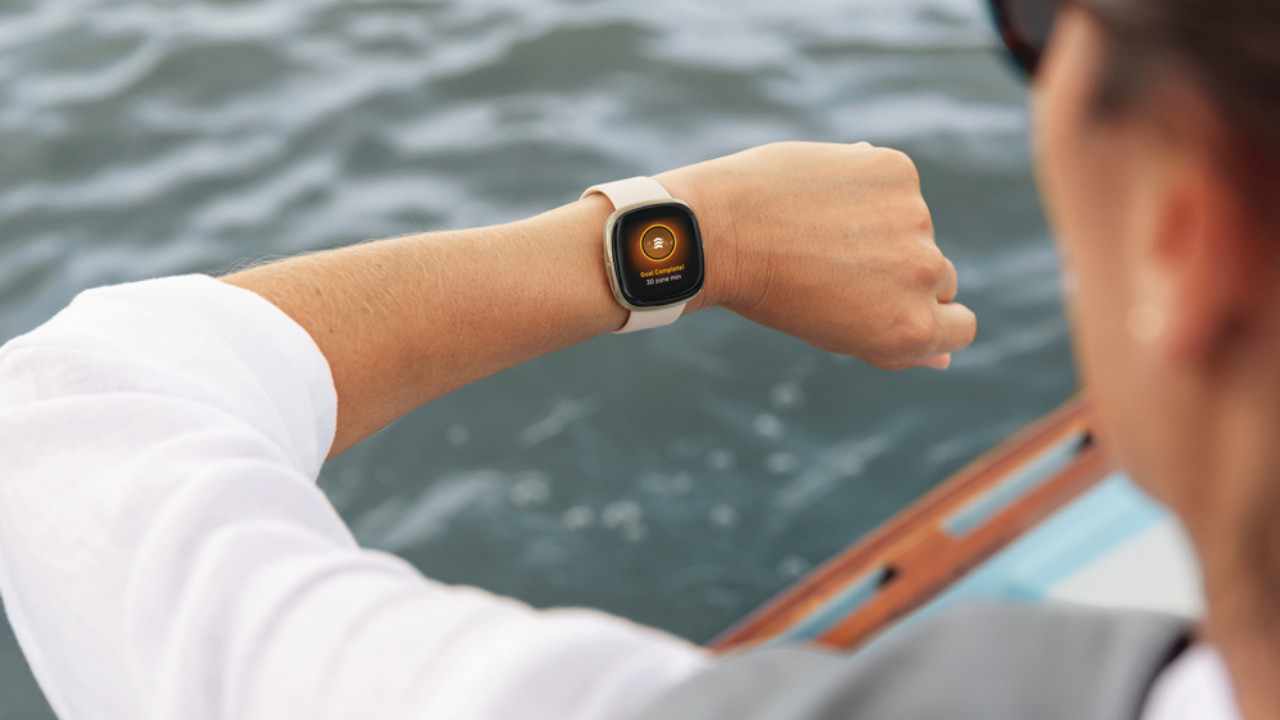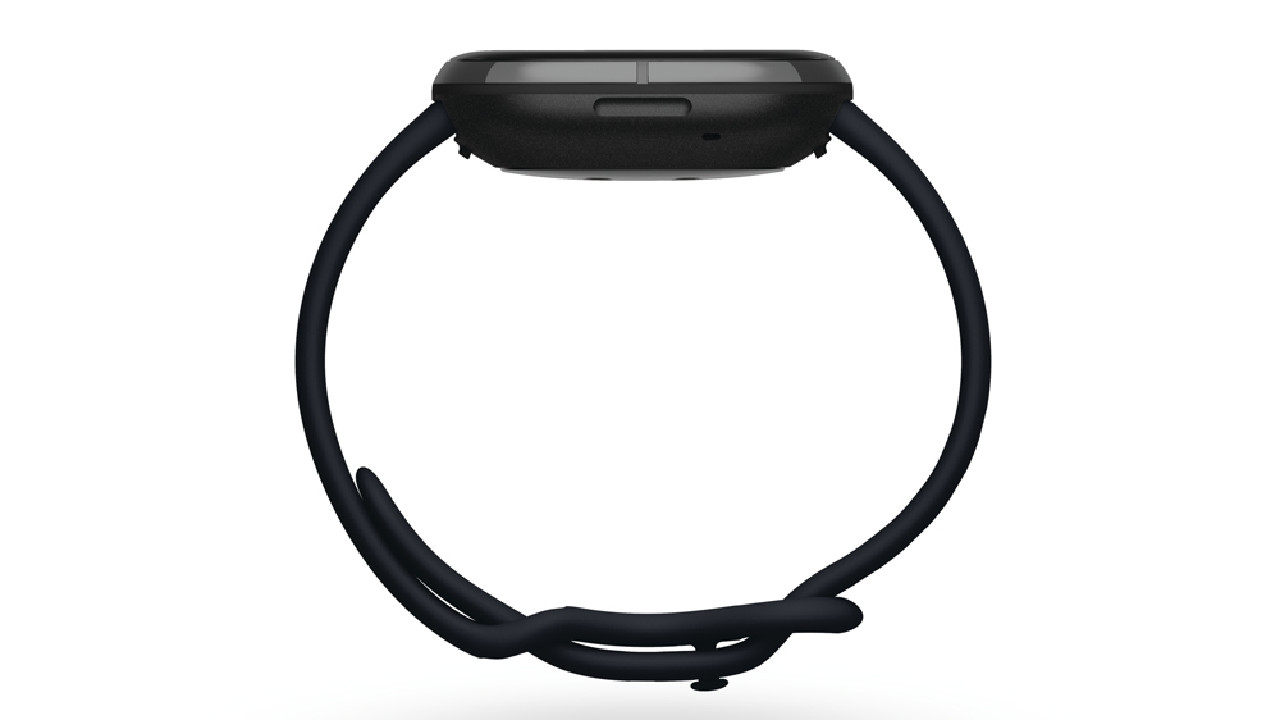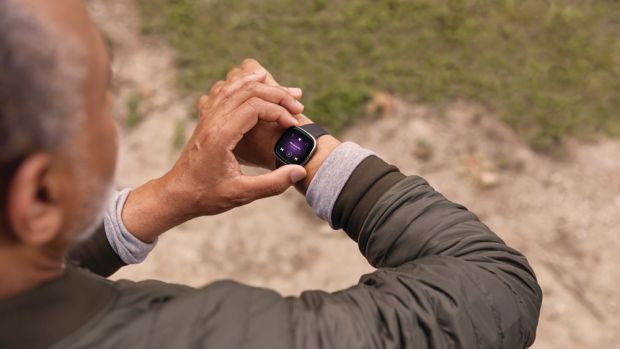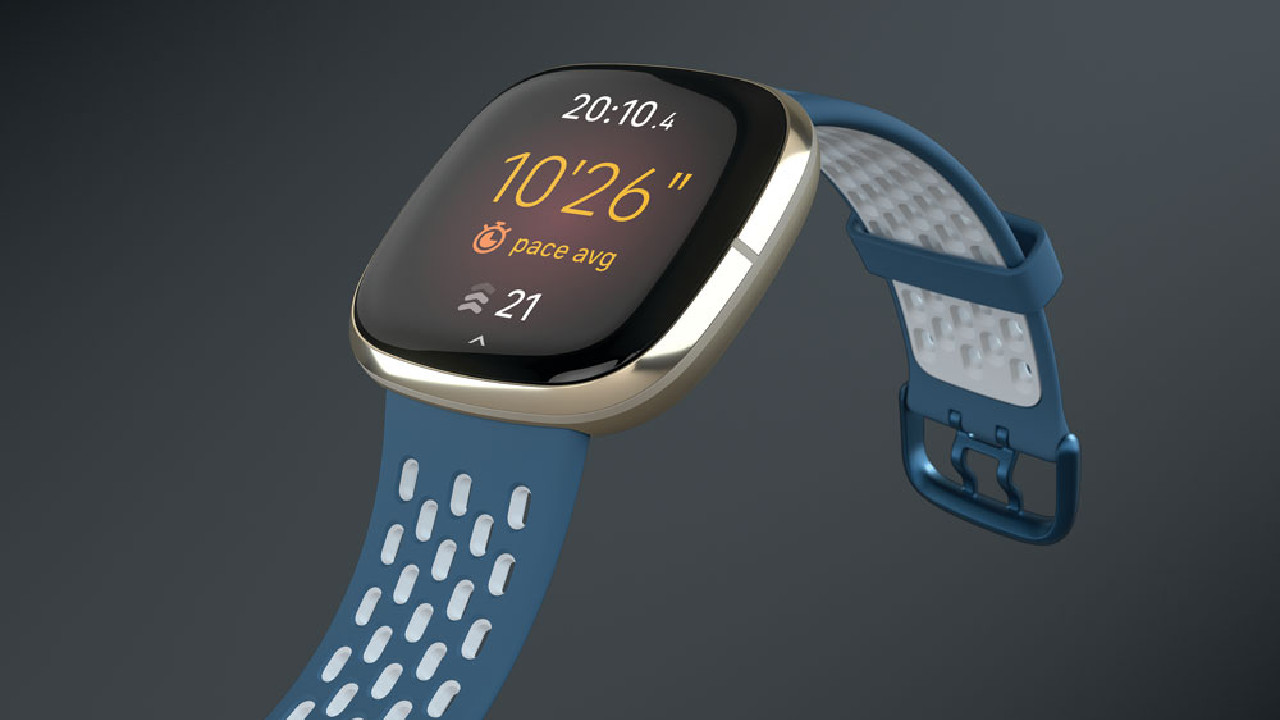Our Verdict
The Fitbit Sense is the company’s flagship device at £299 against the Versa 3’s £199.99. Both watches have a similar design and many of the same features, but the Sense is set apart by the inclusion of advanced health metrics. Most of those metrics are well implemented, and the Sense impresses on the usual Fitbit fronts such as everyday activity and sleep tracking. However the Sense is a let-down in other areas – most notably the poor design and mediocre sports tracking.
For
- ECG, SpO2 and EDA measurements offer deeper insights into health
- GPS tracking comparable to that of dedicated sports watches
- Everyday activity tracking with useful active zone minutes goal
- Impressive sleep tracking
Against
- Sleep tracking insights are hidden behind a paywall
- The touchscreen and touch-sensitive panel fall short of rivals’
- The always-on screen is not bright enough for exercise
- Heart rate tracking has accuracy issues
- The Fitbit app store is limited
- Silicone strap is uncomfortable
You can trust Coach
- Should You Buy Something Else?
- The Fitbit Sense's Health Features
- Tracking Activity With The Fitbit Sense
- Using The Fitbit Sense For Sports Tracking
- The Fitbit Sense’s Design
- Using The Fitbit Charge 4 For Sleep Tracking
- The Fitbit Sense’s Smart Features
- Fitbit Premium
- How Often Will I Have To Charge It?
- NEWSFLASH: Amazon Prime Day Fitbit Deals Rated
Buy from Fitbit | £299.99
Should You Buy Something Else?
The main selling points of the Fitbit Sense are found in its health and fitness tracking and not in its smarts or its sports features, although it will cover the sports tracking needs of casual runners and gym-goers nicely. Despite being a competent watch, it’s hampered by iffy design and star features that many people might not use. The Versa 3 may be a more attractive alternative at £100 less.
Outside of the Fitbit bubble there are a lot of great alternatives. The Apple Watch does have relatively poor battery life – one day compared with the three to four I got from the Fitbit with the always-on screen activated – but it is a proper smartwatch and a better sports tracker than the Fitbit Sense. That’s true even of the cheaper Watch SE at £279, though that doesn’t have an always-on screen, or ECG and SpO2 measurements. At £379 the Apple Watch Series 6 is considerably more expensive than the Sense, but with the added cost of Fitbit Premium at £80 a year to unlock more stats and guided sessions, the upgrade may be worthwhile.
If you’re looking for better sports tracking primarily then it’s easy to find better options than the Sense for less money. The Garmin Forerunner 245 (£249.99) and the Coros Pace 2 (£179.99) are the stand-out picks for runners and, in the case of the Coros, even triathletes.
The Fitbit Sense's Health Features

The Sense’s most exciting new features are the health stats available. These come in the form of electrocardiogram (ECG) measurements, using the new app on the watch, and electrodermal activity (EDA) scans. I’ve seen the former on devices like the Apple Watch (as well as on the Ionic and earlier Versa editions via the third-party paid-for app Fibricheck), but the EDA scans were new to me. You do these easily by holding your palm to the stainless steel bezel on the watch.
The scan detects changes in the sweat in your skin, which indicates your stress levels – the fewer responses measured, the calmer you are. You can do a two-minute scan to get a score, or set up a guided meditation in the Fitbit app and run it during the session. These features are only available on Fitbit Premium, though, which will cost you £7.99 a month (or £79.99 a year) once the six-month free trial you get with the Sense runs out.
The ECG measurement is an equally simple feature to use. Open the app and put your finger and thumb on opposite corners of the screen. After 30 seconds the app tells you if atrial fibrillation – an irregular heartbeat – has been detected.
Sign up for workout ideas, training advice, reviews of the latest gear and more.
The Sense can also monitor your blood oxygen saturation, which has taken on more importance of late because a low reading combined with established coronavirus symptoms could be a sign that you need medical attention. Fitbit makes no claims that the Sense is a medical-grade device though, and when we spoke to a doctor about SpO2 sensors on fitness trackers, he pointed out that it’s easy to get an inaccurate reading. The SpO2 sensor is also limited to taking automatic readings during sleep, unlike the Apple Watch which can perform spot readings on demand.

The Sense has several dedicated SpO2 watch faces, which show your readings from the previous night’s sleep. You can also see how these readings varied overnight in the advanced sleep analytics section of the app, under “restoration”. I found it strange that you can’t do a spot reading of your SpO2 levels, as you can on the Apple Watch Series 6 and other devices that have the sensor, but I’m far from convinced by the usefulness of those spot readings anyway.
Overall, the new health features are impressive and explain the effects activities are having on your body and how you can improve them – but for many users it may be a case of testing them a few times and then forgetting about them. The EDA scans and sessions to reduce stress could have more use in the long term than ECG and SpO2 tracking, so it’s a shame the sessions are locked behind Fitbit Premium.
Tracking Activity With The Fitbit Sense

Fitbit’s excellent everyday activity tracking includes steps, calories and active zone minutes. The latter tracks your progress towards the 150 minutes of moderate cardio activity a week (or 75 of vigorous activity) recommended by the NHS and the World Health Organisation. You can also increase or decrease this goal depending on your fitness level.
The Sense will alert you when you change heart rate zones too, so you know how many minutes you’re earning. A useful feature in principle but limited thanks to the inaccurate readings during exercise.
Your overall cardiovascular fitness is measured by the resting heart rate and cardio fitness score stats provided by the Sense (as they are with any Fitbit device with a heart rate monitor). The latter is an estimate of your VO2 max and is provided in context of your cohort. This isn’t unique to Fitbit but it is more useful than just a simple number.
The Sense will also issue inactivity alerts each hour if you’ve been static for too long, and Fitbits in general are more demanding than watches from other brands on this front. With an Apple Watch I could see off the alert with 30 seconds of movement, whereas with the Sense, and other Fitbits, you need to log 250 steps in an hour to have it count towards your hourly activity chart.
The activity tracking on the Fitbit Sense is good and the valuable but achievable targets to hit are a clear way to help you maintain or improve your fitness – although I find the activity rings system on the Apple Watch more engaging.
Using The Fitbit Sense For Sports Tracking

Fitbit’s watches have never been designed to rival dedicated sports devices like those you get from Garmin and Polar. However, since the Sense is a £300 flagship watch, I hoped that it might offer a little more than the Versa watches to keen sporty types. Unfortunately, that’s not the case.
The sports tracking on the watch is done through the Exercise app, and the watch has built-in GPS to improve the accuracy of outdoor exercise tracking. I found that the Sense was able to lock on to GPS quickly at the start of a run and the distance was tracked accurately compared with the array of sports watches I tested on my other wrist. You can also set off for a run without getting a GPS lock and rely on the Run Detect feature to start tracking your activity automatically, but to me this displays a level of trust I would never grant a watch.
However, the accuracy of GPS wasn’t replicated in the heart rate tracking. Whether I was running, cycling, doing yoga or strength workouts, the Sense was consistent in presenting a completely incorrect heart rate when compared with a chest strap. It was so bad that I’d suggest you completely disregard my testing of it, because other people I know have had better readings, and I can’t believe that my experience of it is common. There wasn’t one single sporting session I did where it was accurate. That of course then threw my active zone minutes target out of whack.
The always-on screen is also not up to snuff for outdoor exercise. During outdoor runs it wasn’t clear enough for me to read easily, even when I set the display to max brightness. This meant that I had to turn my wrist during runs and cycles to activate the screen, negating the purpose of the feature.
While you do get a solid array of stats for running and cycling, it’s not easy to scroll through them using the touchscreen during an activity, and you’re still missing stuff you’ll find on even budget sports watches. There is a general work/rest interval mode that’s useful for any kind of sport, but you can’t create more complicated structured workouts to follow on the watch.
For swim tracking the Sense will record lengths as well as the duration, distance and pace of your pool swim (there’s no open-water mode), and you can set the pool length in the app before you start. The screen will lock in the water, but you can unlock and end the workout by tapping the touch-sensitive panel.
The sports tracking experience on the Sense is just OK, but broadly that’s fine, since this is not a watch aimed at keen sporty types. However, it’s worth saying the experience is no better than on cheaper Fitbit watches, or even the Charge 4 band, and falls short of what you get from sports watches that cost £100 to £200 from other brands.
The Fitbit Sense’s Design

The Sense looks good, and the screen is clear and bright when active, but there’s not much else I can say that’s positive about the design. As mentioned above the always-on screen isn’t bright enough when outdoors, but that’s far from the biggest problem with the watch’s design.
The touch-sensitive panel that has replaced the button on the side of Fitbit’s smartwatches (it’s also on the Versa 3) is a dud. It frequently fails to register a press, which often means mashing it to try to pause a run or other activity. There really was nothing wrong with a button, and I’m amazed this change got through Fitbit’s own testing.
The touchscreen is also not as responsive as I would expect, especially compared with something like the Apple Watch. Almost every time I interacted with the watch it would fail to register a touch or swipe at some point, unless I was very precise.
I also found the silicone band uncomfortable and had to take the Sense off a couple of times at night to get to sleep. There are many other bands available, though, and I’d invest in one of the softer ones if I was going to stick with the watch.
The Sense is not an enjoyable watch to interact with. Given that it’s something you’ll be wearing all the time and indeed interacting with a lot, that’s a problem. This is in huge contrast with the Apple Watch, which offers a great user experience.
Using The Fitbit Charge 4 For Sleep Tracking
The Sense is an excellent sleep tracker, proving both accurate and insightful for me during testing. You get an overall sleep score out of 100, broken down into three sections – overall time asleep (worth 50 points), time in deep and REM sleep (25 points), and restoration (25 points). The restoration section takes into account things like your heart rate and the variation in your blood oxygen saturation at night – high variations can be a sign of breathing problems.
Some of this data is behind the Fitbit Premium paywall, and Premium users will also see suggested programmes to help improve your sleep. Free users can see their sleep score and the stages graph of their night, which shows periods of deep, REM and light sleep.
If you’re keen to get as much detail as you can on your sleep, then really only Polar and perhaps Huawei offer as much insight as you get from a Fitbit. It’s worth saying, though, that you can get this from the cheaper Fitbit Versa 3 as well.
The Fitbit Sense’s Smart Features

Even compared with cheaper Apple and Android devices, the Fitbit Sense is not all that smart. There aren’t a whole lot of apps available for Fitbit’s platform and the Sense doesn’t link with Spotify beyond being able to control it on your phone. Even then you need a Spotify premium account to link it with the Spotify app on a Fitbit, essentially making this feature less useful than the basic playback controls you get on most headphones, which don’t require a premium account.
On Garmin and Samsung devices you can transfer Spotify playlists to the device. You can do this with Pandora and Deezer on a Fitbit, but – to be frank – Pandora and Deezer are minor players. Meanwhile, Fitbit Pay is, like Garmin Pay, lacking in partners in the UK, with Santander being the only high street bank that works with it.
Fitbit Premium
I’ve mentioned Fitbit Premium many times in this review, and it’s pretty annoying that Fitbit has locked certain features behind a paywall – Premium is £7.99 a month or £79.99 a year. While I have a big problem with Fitbit locking detailed stats measured by the watch behind a paywall, I don’t mind paying for extra features like the guided programmes and fitness classes you get from Premium.
These can help to counter the problem of having an advanced fitness tracker but not finding yourself getting any fitter, since the plans cover a wide range of areas, whether it’s a running training plan, or programmes to help you sleep better, lose weight or cut your sugar intake. You get useful advice that can help you make use of the stats the Sense is recording, and the mindfulness sessions work well in tandem with the EDA scans.

However, the experience is not always seamless. When you do a video workout in the Fitbit Premium section of the app it doesn’t interact with the watch until after you’ve finished the session on your phone, when it will grab heart rate data from the watch.
In comparison with the interaction between Apple’s new Fitness+ service and the Apple Watch, where the workout automatically starts on your watch and the stats recorded by the watch are displayed live on whatever screen you’re viewing the workout on, it’s light years behind.
You get a six-month Fitbit Premium trial when you buy a Sense, and it’s certainly worth trying. Overall, however, I don’t think Fitbit Premium is worth £7.99 a month since it’s not all that closely linked up with the Sense. There are many other, better, fitness apps you can buy instead – Fiit is a big favourite of mine for guided strength, HIIT yoga and Pilates sessions, and there are many great diet and nutrition apps available too.
How Often Will I Have To Charge It?
Even with the always-on screen activated and exercising outdoors most days, I generally got through three to four days without having to change the Sense. That’s better than what you get from the Apple Watch or most Android smartwatches on this front, and if you exercise a little less and turn down the brightness on the display you should get the six days listed by Fitbit.
More About Fitbits, Trackers and Smartwatches
- Get both fitness tracking and smart features with the best fitness smartwatches
- Fitbit’s range of fitness trackers and smartwatches cover all the exercise bases – here’s how to pick the best Fitbit for you
- Find the best fitness tracker for you with our buyer’s guide and run-down of Fitbit, Garmin, Apple, Huawei and Samsung models

Nick Harris-Fry is a journalist who has been covering health and fitness since 2015. Nick is an avid runner, covering 70-110km a week, which gives him ample opportunity to test a wide range of running shoes and running gear. He is also the chief tester for fitness trackers and running watches, treadmills and exercise bikes, and workout headphones.

